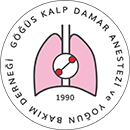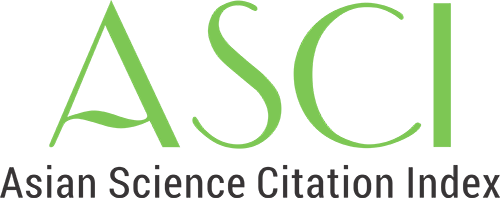

Volume: 28 Issue: 2 - 2022
| OTHER | |
| 1. | Frontmatters Pages I - XII (470 accesses) |
| RESEARCH ARTICLE | |
| 2. | Jaundice and Its Results After Cardiac Surgery Zihni Mert Duman, Barış Timur, Muhammed Bayram, Timuçin Aksu doi: 10.14744/GKDAD.2022.74436 Pages 105 - 112 (1343 accesses) Objectives: Jaundice due to hyperbilirubinemia develops in 1023% of patients in the early period after cardiac surgery. The aim of our study is to examine the risk factors and clinical consequences of hyperbilirubinemia causing jaundice. Methods: In this retrospective study, patients who underwent cardiac surgery in our clinic between February 2015 and March 2021 were evaluated. Patients who underwent routine or emergency surgery, who developed post-operative jaundice, and whose total bilirubin concentration was >3 mg/dL were included in our study. The baseline demo-graphic data, echocardiography data, laboratory data, operative data, and post-operative status were comprehensively collected. The cutoff value of post-operative total bilirubin was calculated according to hospital mortality in receiver operating characteristic analysis. Results: Total bilirubin concentration was found to be >3 mg/dL in 27 patients. Mean total bilirubin (mg/L) was 9.56±6.427 and median total bilirubin score was 9.02 and the maximum bilirubin concentration was reached at 9.52±8.007 post-operative days. In-hospital mortality occurred in 17 (63.0%) patients. The cutoff for post-operative total bilirubin value was calculated as 9.24 by predicting in-hospital mortality (Sensitivity=70.6%, specificity=90%, and likelihood ratio: 7.05). Conclusion: Patients who develop hyperbilirubinemia in the post-operative period of cardiac surgery should be carefully observed for low cardiac output syndrome, sepsis, or acute liver failure. Low-level hyperbilirubinemia is mostly reversible when cardiac output and oxygen delivery are adequate. However, severe persistent hyperbilirubinemia is a condition that needs to be recognized early and precautions should be taken. |
| 3. | Anesthesiologists Awareness of the ERAS Protocol in Cardiac Surgery Senem Girgin, Murat Aksun, Birzat Emre Gölboyu, Ahmet Salih Tüzen, Nagihan Karahan doi: 10.14744/GKDAD.2022.97830 Pages 113 - 121 (1395 accesses) Objectives: This study is aimed at evaluating awareness of the anesthe-siologists working in cardiac surgery related to the perioperative ERAS protocols developed based on evidence and their existing perioperative approaches. Methods: A survey of 30 questions evaluating the knowledge, atti-tudes, and behaviors related to the suggestions regarding perioperative, intraoperative, and post-operative care in the patients with cardiac surgery notified based on evidence in 2019 by the ERAS cardiac association has been directed to anesthesiologists working in the cardiac surgery through E-mail and face-to-face printed forms. Results: The research sample consists of 90 anesthesiologists working in cardiac surgery. It is observed that 31.1% of the participants do not have any idea regarding ERAS protocols. The rate of those routinely measuring HbA1C level is detected as 64.4%, the rate of those routinely measuring albumin level as60%, the rate of those loading carbohydrates as 8%, the rate of those carrying out topical intranasal antimicrobial treatment as 9.1%, and the rate of those routinely applying tranexamic acid or epsilon-aminocaproic acid as 50%. As for the question on the time for IV anti-biotherapy application, 54.4% of the participants have given the answer as immediately after the induction, and 13.3%, the answer as 30 min after the surgery. The rate of the participants measuring the bioindicators toward detection of acute kidney injury has been detected as 2.2%. About 32.2% of them have stated that they use regional anesthesia techniques for analgesia purposes. Conclusion: The perioperative applications of the an esthesiologists in cardiac surgery show compliance with the ERAS guideline; however, approximately one-third of the participants have stated that they do not have any idea related to this protocol. Works relating to increasing the awareness on ERAS protocol becoming more important with each pass-ing day are extremely significant in terms of patient discharge parameters in cardiac surgery. |
| 4. | Can Intraoperative Near-Infrared Spectroscopy Monitoring a Reliable Monitoring Method in Preventing Neurocognitive Dysfunction in Cardiac Surgery? Neurocognitive Monitoring Method in Cardiac Surgery Nur Ürküt Baz, Pınar Karaca Baysal, Pınar Yıldırım özkan, Ömer Faruk Savluk doi: 10.14744/GKDAD.2022.05668 Pages 122 - 128 (576 accesses) Objectives: Our study aims to investigate whether changes in cerebral oximetry as assessed by the use of near infrared spectroscopy are a reliable monitoring method in preventing post-operative neurocognitive dysfunction in patients undergoing cardiac valvular surgery. Methods: The study included 43 patients who were to undertake valvular cardiac surgery between March 2014 and March 2015 and agreed to take part in the study. All patients received cerebral oximetry monitoring by near-infrared spectroscopy before induction and during the operation. The group of patients who demonstrated a ≥20% decrease in cerebral oximetry and received intervention were called Group A (n=18), and the group of patients with a <20% reduction in cerebral oximetry was called Group B (n=25). Neurocognitive assessments were performed 2 days before and 1 week after surgery. The minimental test, visual-spatial functions test, and clock-drawing test were utilized for this purpose. Results: Patients in groups A and B were compared in terms of age, gender, educational status, and additional disease status, and the groups were found to be similar. There was no difference between the two groups in terms of peroperative cardiopulmonary bypass times and cross-clamp times. There was no significant difference between the groups in the minimental test, visual-spatial functions test and clock drawing test values performed one week after the surgery. No significant difference was found in terms of intensive care and hospital stay for these two groups. Conclusion: We believe that near-infrared spectroscopy monitoring against such a decrease and immediate intraoperative intervention as necessary based on near-infrared spectroscopy monitoring may be important in preventing post-operative neurocognitive dysfunctions. |
| 5. | The Effect of Variations in the Neutrophil/Lymphocyte Ratio on The Length of Post-Operative ICU Stay in Cases Diagnosed with Transposition of the Great Arteries Hatice Dilek Özcanoğlu, Erkut Öztürk, Şerife Özalp, Selin Sağlam, İncila Ali Kahraman, Berra Tan Recep, Behzat Tüzün, Cansaran Tanıdır, Funda Gümüş Özcan, Ali Can Hatemi doi: 10.14744/GKDAD.2022.48802 Pages 129 - 134 (517 accesses) Objectives: In this context, the objective of this study is to investigate the effect of variations in the neutrophil/lymphocyte ratio on the length of post-operative intensive care unit (ICU) stay in cases that were diagnosed with transposition of the great arteries (TGA) and who subsequently underwent arterial switch operation (ASO). Methods: This study was conducted with newborns that were diagnosed with TGA, followed up in the pediatric cardiac ICU, and who underwent ASO between January 1, 2021 and December 31, 2021. Variations in neutrophil-lymphocyte ratio (NLR) were recorded before and after the operation (day 1, 2, and 3). The primary endpoint was deemed as the prolonged post-operative ICU stay. For the purposes of this study, a prolonged post-operative ICU stay (PCILOS) was defined as a post-operative ICU stay that falls within the 25th percentile of the lengths of stay with the most extended durations. Results: The patient group comprised 45 patients. The median age of the patients was 3 (interquartile range [IQR] 2-7) days, and the median operation weight was 3000 (IQR 2800-3100) grams. Of the patients included in the study, 51% were male, and 49% were female. Median duration on a mechanical ventilator, the median length of ICU stay, and median length of hospital stay were 48 (IQR 24-96) hours, 6 (IQR 5-12) days, and 12 (IQR 10-16) days, respectively. PCILOS duration was determined as >8 days. Four (8.8%) patients died in the early period. Pre-operative NLR values of >1.5 and post-operative day-3 NLR values of >2.1 were found to be strong predictors of PCILOS. Conclusion: The findings of this study suggest that high NLR values in the pre-operative and early post-operative period in patients that were diagnosed with TGA and who underwent ASO were good predictors of prolonged ICU stays. |
| 6. | Evaluation of the Effect of Del Nido and Cold Blood Cardioplegia on Renal Functions in the Surgery of Congenital Heart Diseases Fatma Ukil Işıldak, Yasemin Yavuz, Sedat Arısüt, Abdullah Arif Yılmaz doi: 10.14744/GKDAD.2022.71501 Pages 135 - 143 (649 accesses) Objectives: We aimed to evaluate the effect of del Nido (DN) and cold blood (CB) cardioplegia on renal functions in children undergoing cardiac surgery for congenital heart disease (CHD). Methods: This study was conducted prospectively. One hundred and nineteen pediatric patients with Risk Adjustment for Congenital Heart Surgery (RACHS) scores below 3 were randomly assigned using allocation software to two groups (CB and DN cardioplegia) according to the type of cardioplegia solution used. The change of urea, creatinine, estimated glomerular filtration rate (eGFR), and renal near-infrared spectroscopy (NIRS) values before and after cardioplegia were the primary outcome measures of this study. Results: Cardiopulmonary bypass (CPB) duration (p<0.001), ACC duration (p<0.001), and extubation time (p=0.032) were longer and the VIS-48th h (p=0.048) value was higher in the DN group. The pre-operative versus 48th h increase in urea were higher in the DN group (p=0.028). The increase in CPB duration was predictive for the increase in urea (p=0.009) and creatinine (p=0.004), and younger age was a predictor for the increase in urea (p=0.014) and decrease in eGFR (p=0.044). Conclusion: Although CPB duration, aortic cross-clamp times, and extubation times are longer in DN cardioplegia recipients, it is as safe as blood cardioplegia in terms of ICU LOS, mortality rates, VIS-initial and VIS-24th h values, and changing renal NIRS, creatinine, eGFR, and urea values during surgery. There is a need for more extensive research on the use of DN cardioplegia in CHD surgery. |
| 7. | Retrospective Comparison of Conscious Sedation and General Anesthesia in Endobronchial Ultrasound-Guided Transbronchial Needle Aspiration Umut Kara, Deniz Doğan, Mehmet Emin İnce, Nesrin Öcal, Yakup Arslan, Fatih Şimşek, Gökhan Özkan, Sami Eksert, Mehmet Burak Eşkin, Serkan Şenkal, Cantürk Taşçı, Ahmet Coşar doi: 10.14744/GKDAD.2022.26937 Pages 144 - 152 (814 accesses) Objectives: : The main objective of this study was to evaluate the procedure characteristics and complication rates of ultrasound-guided endobronchial transbronchial needle aspiration (EBUS-TBNA) performed under conscious sedation (CS) versus general anesthesia (GA). The airway devices used for GA were being evaluated as a secondary aim. Methods: Patients who had EBUS-TBNA at our tertiary hospitals between January 2017 and December 2021 were retrospectively studied. The study included all participants who were 18 years or older and had no missing medical data. The patients were divided into two groups: Those who had CS and those who had GA. Age, gender, ASA physical status, EBUS-TBNA mean number of lymph node (LN) per patient, and complications during the procedure were compared between groups. Results: There were 454 patients (58.7%) in the CS group and 319 patients (41.3%) in the GA group in our sample of 773 patients. Classical laryngeal mask airway (LMA) (92.1%) was the most common in the GA group, whereas number 4 LMA (71.7%) was the most preferred in LMA. In EBUS-TBNA, the average number of aspirated LN procedures per patient was greater in the GA group than in the CS group (1.63 vs.1.32). Complications were more common in the CS group than in the GA group (9.7% vs. 4.4%). Conclusion: The GA approach in EBUS-TBNA was shown to be more successful and safer than the CS approach in terms of number of LNs per patient and complication rates. We also determined that the classic LMA is an appropriate airway device in EBUS-TBNA. |
| 8. | Ultrasound-Guided Erector Spinae Plane Block for Carotid Endarterectomy: A Case Series Ali Sait Kavaklı, Tayfun Sügür, Hayri Fatih Metinyurt, Arzu Karaveli, Burak Aksu, Kadir Sağdıç, Umut Verkal Pekgül doi: 10.14744/GKDAD.2022.88156 Pages 153 - 157 (552 accesses) Objectives: Erector spinae plane (ESP) block can be used for post-operative analgesia following thoracic, abdominal, and lumbar surgeries. Furthermore, it can provide complete surgical anesthesia in some procedures at cervical or thoracic regions. The case series describes use of ESP block in 12 patients who underwent carotid endarterectomy (CEA). Methods: Data were analyzed from 12 patients. Patient characteristics, carotid clamping time, duration of surgery, number of patients requiring intraoperative supplemental local anesthetic, amount of additional local anesthetic administered by the surgeon, opioid requirements during the surgery, time to first requirement for analgesia in intensive care unit, pain scores, post-operative analgesic consumption, and hospital stay were recorded from the patients medical chart. Results: Nine of 12 patients required intraoperative supplemental 2% lidocaine. The median (interquartile range [IQR] [range]) volume of lidocaine used for supplemental infiltration was 6 (5-9 [3-12]) ml. A total of 10 (83.3%) patients requested analgesia in the first 24 h postoperatively. The median (IQR [range]) time of first analgesic requirement postoperatively was 8 (5-10.5 [1-12]) h. Mean hospital stay was 3.1±0.6 days. Conclusion: Although erector spina plane block alone cannot provide complete surgical anesthesia in CEA, it can be used as an alternative to other regional anesthesia techniques in combination with relatively low-dose local anesthetic supplementation, as well as contributing to post-operative analgesia. |
| 9. | Percutaneous Dilatational Tracheostomy Applicatıons in Our Intensive Care Units: A 10-Year Retrospective Study Şule Batçık, Tolga Koyuncu doi: 10.14744/GKDAD.2022.94899 Pages 158 - 163 (619 accesses) Objectives: Percutaneous dilatational tracheostomy (PDT) is an interventional procedure that is widely used in intensive care units (ICUs). This application, which has low complication rates, increases patient comfort and facilitates airway management. However, early and late complications can be seen during and after the procedure. The objective of this study was to perform the clinical evaluation of PDT interventions applied in the ICU over a 10-year period. Methods: A total of 275 patients over the age of 18 who were hospitalized in the Surgical ICU and Anesthesia ICU and underwent PDT between 2010 and 2020 were included in the study. Patients age, gender, diagnosis of hospitalization, comorbid diseases, APACHE-II and Glasgow Coma Scale (GCS) scores, hospitalization and discharge dates, time to open tracheostomy, early and late complications encountered during and after the procedure, decannulation, transplantation, and mortality were retrospectively reviewed. Results: The mean age of the patients was 71.6±14.6 years. During ICU admission, APACHE II scores were 23.3±7.6 and GCS scores were 7.5±3.5. The highest mortality (22%) was in the ischemic or hemorrhagic cerebral injury group. The duration of mechanical ventilation in the ICU was 34.2±19.4 days, and the length of stay in the ICU was 37.2±20.5 days. Time to open a tracheostomy was found as 16.3±7.7 days. PDT was performed in the early (≤10 days) period in 33% of the patients, and in the late (>10 days) period in 67% of the patients. Twenty-seven (9.8%) of the 275 patients develop complications with bleeding being the most commonly seen complication by 4.4%. Conclusion: PDT is a safe procedure due to its low complication rates. However, we think that fiber optic bronchoscopy and ultrasonography, which are frequently used in different applications in ICUs, may also be effective in reducing complications in PDT applications. |
| 10. | Pneumothorax in Patients with COVID-19 in Tertiary Intensive Care Şerife Gökbulut Bektaş, Demet Bölükbaşı, Baha Burak Konak, Ahmet Gökhan Akdağ, Aydan Çalışkan, Seval İzdeş doi: 10.14744/GKDAD.2021.03371 Pages 164 - 171 (450 accesses) Objectives: Objective of the study was to examine the laboratory findings with clinical characteristics and treatments of patients who were hospitalized in a tertiary intensive care unit with the diagnosis of coronavirus disease 2019 (COVID-19) and developed pneumothorax and to determine epidemiology and risks of pneumothorax. Methods: The study was conducted by retrospectively examining the electronic records of 681 COVID-19 patients who were followed up between 1 April 2020 and 1 January 2021 in 3 tertiary intensive care units (each was 24 beds). Patients demographic and clinical characteristics, laboratory findings, mechanical ventilator parameters and chest imaging were evaluated retrospectively. Results: Pneumothorax in 22 (3.2%) of 681 with COVID-19 patients was detected and acute respiratory distress syndrome (ARDS) in 481 (70.6). All the study patients met ARDS diagnostic criterias. Mortality rates were 43.4% (296/681) in all patients, 52.8% (254/481) in patients with ARDS, and 86.3% (19/22) in patients with pneumothorax. Pneumothorax occurred in the patients within a mean of 17.4±4.8 days. The computed tomographies of patients were observed common ground-glass opacities, heterogenic distribution with patch infiltrates, alveolar exudates, interstitial thickening in the 1st week of their symptom onset. Conclusion: We observed that pneumothorax significantly increased mortality in COVID-19 patients with ARDS. We believe that understanding and preventing the characteristics of pneumothorax will make an important contribution to mortality reduction. |
| 11. | The Importance of CMV Reactivation in COVID-19-Related ARDS Patients Lerzan Doğan, Zeynep Tuğçe Sarıkaya, Bülent Güçyetmez, İbrahim Özkan Akıncı doi: 10.14744/GKDAD.2022.40327 Pages 172 - 177 (635 accesses) Objectives: Cytomegalovirus (CMV) reactivation is a significant cause of morbidity and mortality in critically ill patients. Existing or newly developed immunosuppression appears to be the main factor for reactivation. COVID-19 patients with acute respiratory distress syndrome can be affected by a variety of conditions that cause immunosuppression. Clarifying CMV reactivation and notably its predictive features became important during the epidemic. Methods: This is a retrospective, observational, and cohort study. All COVID-19 patients admitted to the ICU between March 11, 2020 and March 11, 2021 were analyzed. All of the information was gathered from the hospitals electronic records. CMV reactivation was defined as CMV DNA ≥1000 copies/ml in tracheal samples. The patient population was analyzed in two groups, namely, patients with CMV reactivation and patients without reactivation. Results: During the study period, 99 of all COVID-19 ARDS patients fulfilled the inclusion criteria, and CMV reactivation was detected in 55 (55.6%) of them. Age, BMI, APACHE-II score, hypertension, chronic respiratory disease, the usage of interleukin blockers, the duration of steroid usage, procalcitonin (PCT), and CD-8 T-cell levels differed significantly from the patients without CMV reactivation. Furthermore, the reactivation group had longer ICU stays, longer durations of mechanical ventilation, and higher mortality. Conclusion: CMV can be reactivated in critically ill COVID-19 ARDS patients, which appears to correlate with worse outcomes. Obesity, the usage of IL-blockers and steroids >12 days, high PCT, and low CD-8 T-cell levels appear to be risk factors. Critically ill COVID-19 patients should be closely monitored with regard to immunosuppression and CMV status. |
| 12. | Pneumothorax and Pneumomediastinum in Patients admitted to Intensive Care Unit with COVID-19 Pneumonia: A Single-Center Retrospective Analysis Kazım Rollas, Taner Çalışkan, Tunzala Yavuz, Işıl Köse Güldoğan doi: 10.14744/GKDAD.2022.54366 Pages 178 - 183 (652 accesses) Objectives: This study aimed to examine the frequency, and clinical features of pneumothorax and pneumomediastinum cases in patients admitted to the intensive care unit due to coronavirus disease-19 (CO-VID-19) pneumonia. Methods: We retrospectively screened the COVID-19 cases hospitalized in our intensive care unit between March 11, 2020, and January 11, 2022. Patients diagnosed as pneumothorax or pneumomediastinum were determined. The frequency and clinical features of pneumothorax and pneumomediastinum were investigated. Results: Seven hundred and twenty patients hospitalized in our intensive care unit between March 11, 2020, and January 11, 2022 were screened. Twenty-four (3.3%) patients had pneumothorax or pneumomediastinum. Pneumothorax occurred 17 patients (70%), and pneumomediastinum in 14 patients (58%). The number of patients who developed pneumomediastinum and pneumothorax together was 7 (29%). COVID-19-associated pneumothorax tended to be unilateral (n=16) and right-sided (n=11). In 18 (75%) patients, pneumothorax or pneumomediastinum developed during invasive mechanical ventilation, 5 (20.8%) patients during non-invasive mechanical ventilation. One patient developed pneumothorax when mechanical ventilation was not applied. The mortality rate at 60 days was 75% (n=18) in patients who were admitted to the intensive care unit with CO-VID-19 and developed pneumomediastinum or pneumothorax. Conclusion: Pneumothorax and pneumomediastinum are complications of COVID-19 pneumonia with high mortality rates. |
| 13. | The use of Therapeutic Hypothermia in Patients Having Cardiac Arrest Gönül Erkan, Buket Özyaprak, Ferdane Aydoğdu Kaya, Dursun Topal, Yılmaz Apaydın, Nail Kahraman, Ayşe Baysal doi: 10.14744/GKDAD.2021.03274 Pages 184 - 190 (700 accesses) Objectives: Therapeutic hypothermia (TH) is applied to regain the quality of life in patients whose spontaneous blood circulation returns after cardiopulmonary resuscitation (CPR). In our study, we investigated the effects of TH after CPR. Methods: The findings of patients who underwent TH (Group 1, n=32) were compared with those of normothermic patients (Group 2, n=37) in this retrospective study. Recorded data were demographic data, comorbid diseases, causes of cardiac arrest, cardiac arrest rhythms, return times of spontaneous circulation, Glasgow coma scale, deep tendon reflex and brainstem reflex, extubation times, durations of intensive care unit (ICU) stay, and complications. Results: Extubation time in Group 1 (4.74±2.80 days) was shorter than in Group 2 (9.55±10.16 days). The length of stay in the ICU was shorter in Group 1 (7.96±5.10 days) compared to in Group 2 (13.40±11.40 days). Incidence of epileptic seizure activity was lower in Group 1 (16.2%) than in Group 2 (46.9%). Although Glasgow coma scale score evaluated at discharge was higher in Group 1, this difference was not statistically significant (p>0.05). Conclusion: We consider that the use of TH in patients whose spontaneous blood circulation was restored by CPR procedure after cardiac arrest has significant and positive effects on recovering the quality of life. |
| CASE REPORT | |
| 14. | Anesthetic Approach in a Case of Concurrent Off-Pump Coronary Bypass and Lung Resection Elvin Kesimci, Deniz Sivrioğlu, Zeynep Kayhan doi: 10.14744/GKDAD.2022.85698 Pages 191 - 194 (472 accesses) At present, as the elderly population increases, the number of patients with either heart disease or lung cancer also increases. Some of these patients are diagnosed to have concurrent lung cancer or coronary artery, heart valve disease during pre-operative evaluations. In both cases, the anesthetic management of these patients is challenging. In this case, we aimed to present our anesthesia experience in a patient who underwent concurrent off-pump coronary artery bypass grafting and left lung upper lobectomy. |
| 15. | Cesarean Delivery under Spinal Anesthesia in a Parturient Having Complete Atrioventricular Block without Pacemaker and Failed Spinal Anesthesia Management Ülgen Öztürk Toyran, Gözde İnan, Esin Tekin, Dudu Berrin Günaydın doi: 10.14744/GKDAD.2022.46548 Pages 195 - 199 (484 accesses) Although congenital complete atrioventricular block (AVB) is rare, it constitutes a very important comorbidity in pregnant women, because it can be mortal due to the cardiovascular physiological changes during pregnancy and delivery. There is no consensus for anesthetic management of cesarean delivery of pregnant women with congenital complete AVB. In this case report, we aimed to discuss our approach to failed spinal anesthesia for a parturient with congenital AVB scheduled to undergo cesarean section under neuraxial anesthesia in the light of the literature. |
| RETRACTION | |
| 16. | Retraction Page 200 (372 accesses) Abstract | |

















